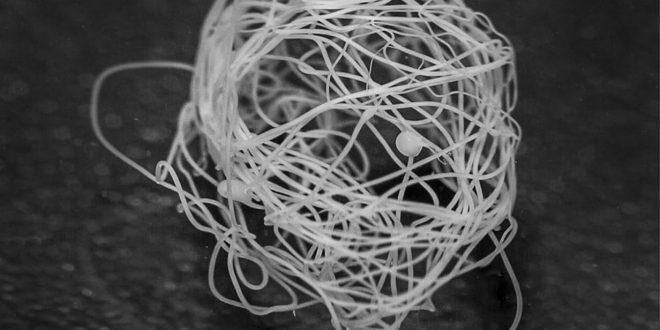Researchers have created a cheaper, simpler and twice as strong synthetic version of spider silk – but the process was still wholly inspired by nature.
Scientists Anna Rising, Jan Johansson, and Marlene Andersson working at the Swedish University of Agricultural Sciences (SLU) and at Karolinska Institutet took advantage of this knowledge to help create an artificial spider silk protein in bacteria that can then be bred en masse to produce industrial quantities of web material.
Spider silk is an attractive material–it is well tolerated when implanted in tissues, it is light-weight but stronger than steel, and it is also biodegradable. However, spiders are difficult to keep in captivity and they spin small amounts of silk. Therefore, any large scale production must involve the use of artificial silk proteins and spinning processes. A biomimetic spinning process (that mimics nature) is probably the best way to manufacture fibers that resemble real spider silk. Until now, this has not been possible because of difficulties to obtain water soluble spider silk proteins from bacteria and other production systems, and therefore strong solvents has been used in previously described spinning processes.
Spider silk is made of proteins that are stored as an aqueous solution in the silk glands, before being spun into a fiber. Researcher Anna Rising and her colleagues Jan Johansson and Marlene Andersson at the Swedish University of Agricultural Sciences and at Karolinska Institutet have previously shown that there is an impressive pH gradient in the spider silk gland, and that this well-regulated pH gradient affects specific parts of the spider silk proteins and ensures that the fiber forms rapidly in a defined place of the silk production apparatus.
This knowledge has now been used to design an artificial spider silk protein that can be produced in large quantities in bacteria, which makes the production scalable and interesting from an industrial perspective.
“To our surprise, this artificial protein is as water soluble as the natural spider silk proteins, which means that it is possible to keep the proteins soluble at extreme concentrations”, says Anna Rising.
To mimic the spider silk gland, the research team constructed a simple but very efficient and biomimetic spinning apparatus in which they can spin kilometer-long fibers only by lowering the pH.
“This is the first successful example of biomimetic spider silk spinning. We have designed a process that recapitulates many of the complex molecular mechanisms of native silk spinning. In the future this may allow industrial production of artificial spider silk for biomaterial applications or for the manufacture of advanced textiles”, says Anna Rising.
Agencies/Canadajournal
 Canada Journal – News of the World Articles and videos to bring you the biggest Canadian news stories from across the country every day
Canada Journal – News of the World Articles and videos to bring you the biggest Canadian news stories from across the country every day



